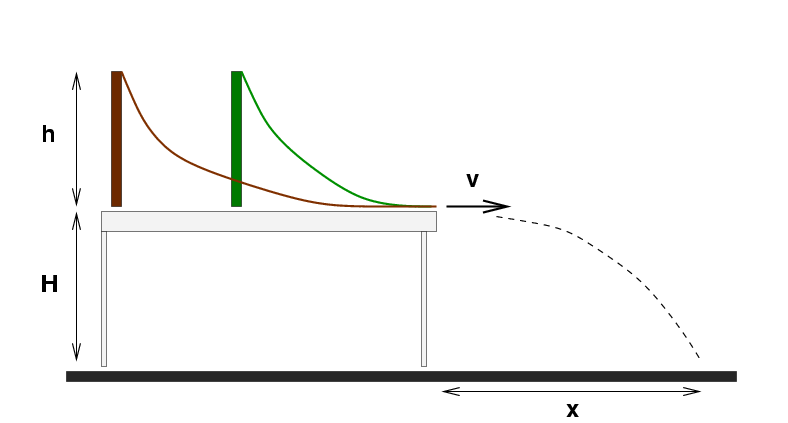 Copyright © Michael Richmond.
This work is licensed under a Creative Commons License.
Copyright © Michael Richmond.
This work is licensed under a Creative Commons License.
A really SMALL rollercoaster

Let's build our own very small roller coaster here
in the classroom. I'll set up a pair of towers,
each of height h above the tabletop.
A car of mass m will roll down the track from each tower
to the edge of the table, then fly outwards
with some initial horizontal velocity v.
As it falls a distance H to the floor,
the car will cover a horizontal distance x.
First, compute some quantities in general:
use symbols only, no numbers.
- Write an expression for the kinetic energy,
potential energy, and total energy of
the car when it is motionless at the top of the track.
What is the origin of your coordinate system?
What is the zeropoint of your potential energy?
- Write an expression for the kinetic energy,
potential energy, and total energy of the
car when it is about to fly off the table.
- What will the car's velocity v be when
it flies off the table?
- How far x will the car move horizontally
as it falls to the floor?
Does this distance depend on the mass of the car?
Now, I'll give you the quantities for the actual
equipment in our example; that is, the height h,
etc.
- What is the car's total energy?
- What will the car's velocity v be when
it flies off the table?
- How far x will the car move horizontally
as it falls to the floor?
optional
- Suppose that there is some friction between car and
track. Will there be any difference between the
distance x when the car runs down one track
versus the other track?
If so, which track will yield a larger value of x?
- Using the actual distance(s) travelled by the car
in each case, very roughly estimate the
kinetic of rolling friction between car and track.
 Copyright © Michael Richmond.
This work is licensed under a Creative Commons License.
Copyright © Michael Richmond.
This work is licensed under a Creative Commons License.

 Copyright © Michael Richmond.
This work is licensed under a Creative Commons License.
Copyright © Michael Richmond.
This work is licensed under a Creative Commons License.

 Copyright © Michael Richmond.
This work is licensed under a Creative Commons License.
Copyright © Michael Richmond.
This work is licensed under a Creative Commons License.